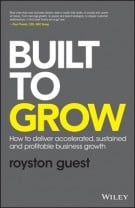By Royston Guest, author
One of the single-most competitive advantages for businesses today is their ability to grow, nurture, and develop leadership and management capability faster than the competition – future business success depends on it.
That’s a bold statement to make, but I passionately believe in it, and more importantly, I have seen it have a profound impact in thousands of businesses of all shapes and sizes.
If you want to accelerate and fast track the success of your business, and build sustained high performance, developing your leadership culture is among your biggest priorities.
If you’re a sole trader, leadership and management responsibility probably sits with you. If you’ve got a small team, it is more important than ever as you need every single one of your people aligned and performing at their peak.
If you run a much bigger organisation, creating consistency and building strength at every level is critical to succession planning, creating the stretch, and the capacity to grow your business.
LEADERSHIP CULTURE
There are usually two distinct groups of people: leaders and followers. The leader-follower structure has been with us for generations and is perpetuated through organisations to this very day.
A hierarchical, command and control structure with decision-making from the top is what we know, and for good reason. Throughout history, a number of great achievements have been accomplished through the leader-follower model, and it has enabled many people to achieve success in their chosen field. It is exactly because the leader-follower way of doing business has been so successful that it is so hard to give up.
In our modern world, the most important work we do is cognitive, and the leader-follower structure just isn’t a very good model for intellectual work.
Differing motivations and aspirations, particularly from one generation to the next, only exacerbate the problem and demand an alternative approach.
There are usually two distinct groups of people: leaders and followers
People who are treated like followers have the expectations of followers and act like followers. That means they have limited decision-making authority and little incentive to give the utmost of their intellect, energy, and passion. Those who take orders usually run at half-speed, under utilising their imagination and initiative.
In a leader-follower model, all decision-making defaults to the leader and therefore the organisation gets squashed, constrained, and contracted, reducing the headspace to grow the organisation.
It can be particularly challenging when the leader is exceptionally charismatic, or worse, when they’re an out-and-out autocrat, because the ability of people to shine is increasingly limited over time.
In a leader-follower structure, the performance of the organisation is closely linked to the ability of the key leader at the top, so inevitably there is a natural tendency to develop personality-driven leadership; an approach that might deliver short-term results, but will never allow you to build a high-performing, sustainable, legacy organisation.
THE SOLUTION: LEADER-LEADER MODEL

Royston Guest
A leader-leader structure is fundamentally different from the leader-follower model. At its core is the belief that we can all be leaders, and in fact, it’s best when we all are.
The leader-leader model not only achieves great improvements in effectiveness and morale but also makes the organisation stronger. Critically, these improvements are enduring, decoupled from the leader’s personality and presence. Leader-leader structures are significantly more resilient, and they do not act as if the designated leader is always right.
Further, leader-leader structures naturally spawn additional leaders throughout the organisation. It’s a force that can’t be stopped.
Implementing a leader-leader structure and developing a leadership culture does not happen overnight. It takes focus and commitment, and requires consistency of thought and action.
It operates from a solid core of personal ownership, each individual taking responsibility and accountability for their actions and results; where everyone thinks, feels, and acts like it’s their business, regardless of their job title, office, or place on the hierarchy. It’s where individuals:
- Are enterprising, entrepreneurial and proactive
- Are focused on getting to the solution rather than concentrating on the problem (the glass is definitely half full, not half empty!)
- Do whatever it takes to build a legacy world-class business that is revered by the competition, sets the benchmark for industry standards, and is known as a great place to work
- Are concerned about results and outcomes, and do their part to reduce costs
- Take personal ownership for achieving results that move the business forward (whether they work in the post room or sit in the boardroom)
- Shape the culture, stay positive, and lead by example
Implementing a leader-leader structure and developing a leadership culture does not happen overnight
Which are you building in your organisation? Do you have a leader-follower structure based on short-term results or a leader-leader culture for a high performing, sustained, legacy organisation?
 About the author
About the author
A relentless itch to join the working world saw Royston Guest kick-start his career at the age of 16, enrolling on a construction apprenticeship programme.
Driving sustainable and profitable business growth fast whilst unlocking the real potential of individuals are his two professional missions spanning over two decades, 27 countries, and tens of thousands of businesses across a multitude of sectors, enterprises, and governments.
Whether speaking, facilitating, consulting, or coaching, Royston’s passion to make a real tangible difference is at the forefront of his work.
Royston Guest is author of Built to Grow, a blueprint to help entrepreneurs, business owners and professionals understand the guiding principles of accelerated, sustained and profitable business.
Built to Grow is available to buy from Amazon. Visit Royston’s website to discover how to join his Facebook or LinkedIn group and access exclusive content, articles and insights on how you can deliver accelerated, sustained and profitable business growth.




